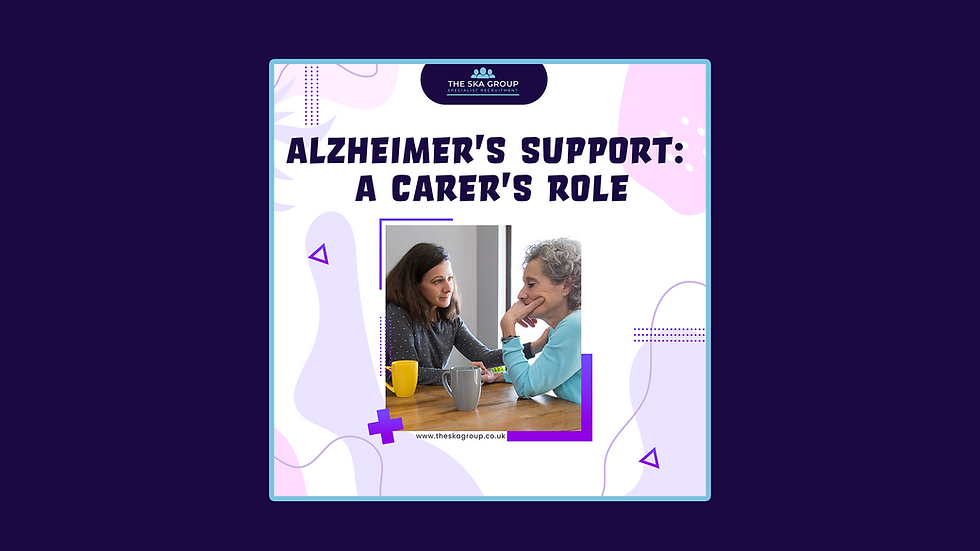Supporting Someone with Deafblindness
- Emily

- Jun 23
- 4 min read
Deafblindness — also referred to as dual sensory impairment or loss — is a condition that affects both hearing and vision. It doesn’t necessarily mean a complete loss of both senses, but it does significantly impact how someone communicates, accesses information, and moves through the world.
According to recent surveys, around 400,000 people in the UK are deafblind. Each person experiences it differently, and the level of support required varies from individual to individual.
Whether you are a family member, friend, or professional carer, understanding the complexities of deafblindness is essential to providing meaningful, respectful support.
1. Understanding the Spectrum of Deafblindness
Deafblindness exists on a wide spectrum. Some people may be born deafblind (congenital deafblindness), while others may acquire it later in life due to illness, injury, or age-related conditions (acquired deafblindness).
Key facts:
Congenital deafblindness may result from conditions such as CHARGE syndrome or rubella during pregnancy.
Acquired deafblindness can happen gradually, especially with ageing — making it harder to identify and diagnose.
Support Tip: Always tailor support to the individual’s experience. Avoid assumptions. Instead, ask questions and listen to how they describe their needs.
2. Communication Is Key
Communicating with someone who is deafblind may require adapting to different techniques, depending on their level of hearing or sight.
These may include:
Tactile signing: Sign language received through touch.
Deafblind manual alphabet: Spelling words into someone’s hand.
Braille or Moon alphabet for reading and writing.
Speech or lipreading, when partial hearing/vision remains.
Technology such as screen readers, hearing aids, or text-based communication apps.
Support Tip: Be patient and flexible. Allow extra time for conversations, and ensure you have the person’s attention before communicating — for example, by gently touching their arm.
3. The Importance of Routine and Predictability
Many people with deafblindness rely on structure and consistency to feel secure and in control. Routines help reduce anxiety and make environments more manageable.
How to create helpful routines:
Establish consistent times for meals, hygiene, and activities.
Keep items in familiar, labelled places.
Use tactile calendars or timepieces to support orientation.
Support Tip: Even small disruptions can feel overwhelming — inform the person of any upcoming changes and involve them in planning adjustments.
4. Promoting Independence and Autonomy
Supporting someone doesn’t mean doing everything for them. In fact, over-helping can unintentionally limit independence.
Ways to encourage autonomy:
Offer choices frequently and clearly.
Involve the individual in decisions about their care, daily schedule, and personal preferences.
Provide tools and training for independent living, such as mobility skills or assistive tech.
Support Tip: Let people take the lead where possible. Even if something takes longer, it’s worth the boost in confidence and control.
5. Safe Mobility and Orientation
Moving around safely can be a challenge with combined sensory loss, especially in unfamiliar or busy environments. Orientation and mobility training may help, but daily support remains vital.
How you can help:
Learn guiding techniques (such as the “sighted guide” method).
Provide tactile or high-contrast cues (e.g., textured floor markers, bump dots).
Ensure environments are free from hazards and remain consistent.
Support Tip: Never move or rearrange furniture or objects without telling the person first — even helpful intentions can cause confusion or injury.
6. Combating Isolation Through Connection
Deafblindness can lead to extreme isolation, particularly when communication becomes difficult. Loneliness is a real risk — but it doesn’t have to be inevitable.
Support emotional and social wellbeing by:
Encouraging participation in group activities with accessible adaptations.
Supporting the person to maintain friendships and family ties.
Facilitating hobbies like music, gardening, tactile art, or swimming.
Support Tip: Just being present and engaged can make a big difference. A simple hand hold, smile, or shared laugh builds connection and trust.
7. Practical Help and Assistive Technology
Technology can unlock new levels of independence. Many modern tools are designed specifically to support people with sensory impairments.
Useful assistive devices:
Vibrating alarms and watches.
Braille displays and audio readers.
Text-to-speech or speech-to-text apps.
GPS devices designed for sensory navigation.
Smartphones and tablets with accessibility features.
Support Tip: Explore what works best for the individual — and help them get training and access to funding or grants if needed.
8. Respecting Rights, Choice, and Consent
People with deafblindness have the same rights as anyone else — the right to make choices, to be heard, and to live with dignity and autonomy.
Always:
Ask permission before offering help.
Include the person in conversations about their care.
Acknowledge their preferences and boundaries.
Support Tip: Shift from a mindset of “protecting” to one of “empowering.” Respecting choice means accepting that risk-taking is part of a full life.
9. Involve Family, Friends, and the Wider Community
Care shouldn't fall on one person’s shoulders alone. Family, friends, and the community can all contribute to a positive support network.
How to expand the support circle:
Educate others about deafblindness and how they can help.
Encourage local businesses and public spaces to be more accessible.
Connect with organisations like Sense for advice, services, and community events.
Support Tip: Encouraging peer connection with others who are deafblind can be incredibly affirming and reduce feelings of isolation.
10. Keep Learning, Stay Open
Every person with deafblindness is unique. The more you learn, listen, and stay adaptable, the more impactful your support will be.
Continue growing by:
Attending training sessions and awareness workshops.
Reading resources or joining support groups.
Reflecting on feedback and always being willing to adapt your approach.
Support Tip: The most powerful support starts with empathy and willingness to learn — not perfection.
Final Thoughts
Caring for or supporting someone with deafblindness isn’t just about helping with tasks. It’s about recognising the full person behind the diagnosis — their preferences, rights, hopes, and strengths.
By focusing on communication, choice, inclusion, and mutual respect, you help create a world where people with deafblindness not only live — but thrive.




Comments